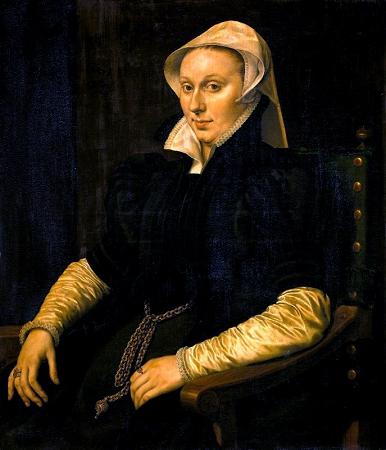Steven van der Meulen (c1520 - c1564). Steven van der Meulen was a Flemish artist active c. 1543-1564. He gained prominence in England in the first decade of the reign of Elizabeth I as one of many Flemish artists active at the Tudor court. He is best known for the Barrington Park portrait type of Elizabeth I and for three-quarter length portraits of members of the English court in the first half of the 1560s. A recently discovered will indicates that he died in London between October 1563 and January 1564. Little is known about van der Meulen's personal life. His father was Rinnold van der Meulen. He was probably born in Antwerp, where he studied under Willem van Cleve the Younger in 1543 and was admitted to the Guild of St Luke in 1552. He was in London by September 1560, is recorded as a member of the Dutch congregation there in June 1562, and was naturalized on 4 February 1562. In 1561 the English merchant John Dymocke or Dymoch visited Sweden in connection with negotiations for a marriage between Elizabeth and Erik XIV, taking with him a Netherlandish painter described as Master Staffan to paint the portrait of the King. It is generally accepted that this was van der Meulen. In 1935, W. G. Constable identified this portrait with a full-length of Erik XIV at Gripsholm Castle, Mariefred, near Stockholm. Scholar Elizabeth Drey has recently discovered van der Meulen's will, dated 5 October 1563 during an epidemic of the plague in London and proved on 20 January 1564. His will indicates that his wife Gertrude Stubbeleeren and children Rinnold and Eric were resident in London with him at the time of his death. Van der Meulen's portraits in a simplified version of the sombre style of Anthonis Mor appealed to patrons at the English court in the early 1560s, and works by him dating to that period are recorded in the 1590 inventory of the paintings of John Lumley, 1st Baron Lumley where he appears as the famous paynter Steven. The recently discovered will, if accepted, indicates that many of the portraits dated 1564-68 attributed to van der Meulen by Roy Strong in the 1960s must now be reassessed, including two portraits of Robert Dudley, 1st Earl of Leicester. A portrait pattern of Queen Elizabeth dating to the mid-1560s is confidently attributed to van der Meulen. Called by Strong the Barrington Park type after a representative example, these sophisticated portraits are probably a response to a proclamation of 1563, which was designed to counter the existence of many unflattering images of the Queen. A life-size portrait of this type c. 1563 by van der Meulen, identified as the earliest full-length portrait of Elizabeth and possibly associated with the various marriage negotiations of the early 1560s, was auctioned by Sotheby's in November 2007 for E2.6 million, more than twice its expected price of E700,000-E1 million. The discovery of van der Meulen's will dated 1563 and proved in 1564 has raised questions about the identification of the paynter Steven and Master Staffan with van der Meulen. In the Spring 2009 issue of The British Art Journal Bendor Grosvenor proposed an alternative identification of the painter Steven with the medallist Steven van Herwijck. This new identification has been accepted by a number of institutions, such as Historic Royal Palaces, Tate Britain and the V&A, who have exhibited the above full-length portrait of Elizabeth I as attributed to van Herwijck. In her 2014 study of the portraiture and patronage of Robert Dudley, 1st Earl of Leicester, Elizabeth Goldring raises concerns with identification of van Herwijck as the paynter Steven. Recent dendrochronological study of the portrait of John Lumley in the National Portrait Gallery reveals that the painting is correctly dated to the 1570s or 1580s, after the documented deaths of both van der Meulen and van Herwijck. Of the identification of the painter, the NPG says The style of painting is consistent with an Anglo-Netherlandish artist from this period. However, as both van der Meulen and van Herwijck died in the 1560s the artist responsible for NPG 5262 must remain as an as yet unidentified emigre.
more...






